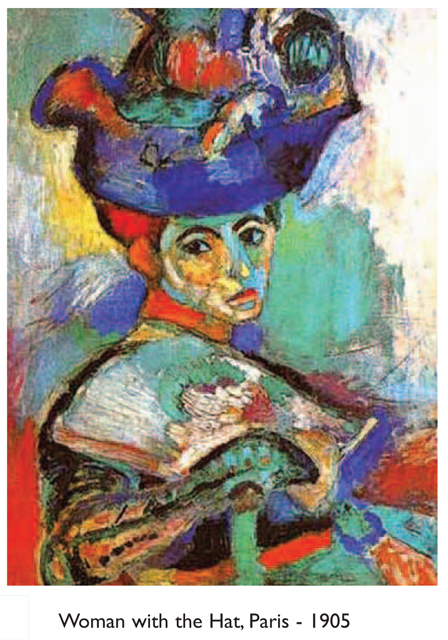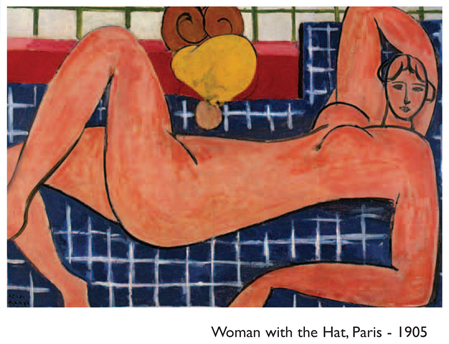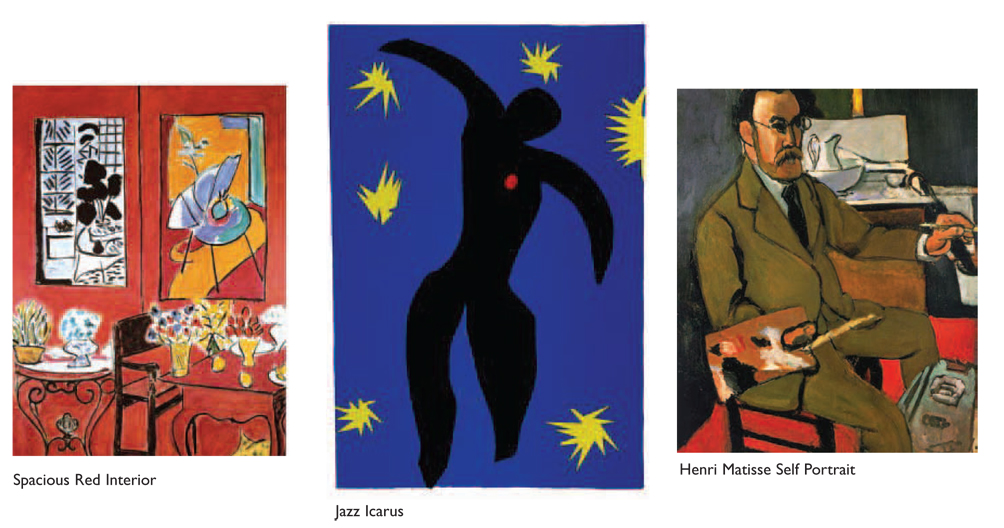
 Unlike most artists, Henri Matisse achieved
popularity and international fame during his own
lifetime. Working primarily as a painter, he is
considered one of the most significant artists of the
20th century. Matisse fought for artistic freedom,
perhaps as a reaction to the passing Victorian Era,
and moved Art into the Modern Era. Even Picasso
said, "There is only one Matisse." The San Francisco
Museum of Modern Art displays his painting, Woman
with a Hat: Madame Matisse (1905) in prominent
view. In the
p a i n t i n g ,
Matisse boldly
used areas of
color to form the
woman's face
with a riot of
greens, pinks
and blues. This
was a shocking
use of color
when it was
painted in 1905
and secured his
reputation as
"King of The
Fauves." Henri
Matisse hadn't
planned on
becoming an
artist. Born in
northern France
in 1869, he was the often sick, oldest of three sons.
He moved to Paris initially to become a law clerk as
his father wished, but at the age of 21 was sidelined
with appendicitis. While bedridden he painted and
when he regained his health he entered art school. As
a young art student he was influenced by
Impressionist, especially Manet, as well as Post
Impressionist, such as Gauguin and Van Gogh. Paul
Cezanne, above all had a profound effect upon
Matisse and his art. Now - the new group of artists in
the early 1900's, were The Fauves, of which Matisse
Unlike most artists, Henri Matisse achieved
popularity and international fame during his own
lifetime. Working primarily as a painter, he is
considered one of the most significant artists of the
20th century. Matisse fought for artistic freedom,
perhaps as a reaction to the passing Victorian Era,
and moved Art into the Modern Era. Even Picasso
said, "There is only one Matisse." The San Francisco
Museum of Modern Art displays his painting, Woman
with a Hat: Madame Matisse (1905) in prominent
view. In the
p a i n t i n g ,
Matisse boldly
used areas of
color to form the
woman's face
with a riot of
greens, pinks
and blues. This
was a shocking
use of color
when it was
painted in 1905
and secured his
reputation as
"King of The
Fauves." Henri
Matisse hadn't
planned on
becoming an
artist. Born in
northern France
in 1869, he was the often sick, oldest of three sons.
He moved to Paris initially to become a law clerk as
his father wished, but at the age of 21 was sidelined
with appendicitis. While bedridden he painted and
when he regained his health he entered art school. As
a young art student he was influenced by
Impressionist, especially Manet, as well as Post
Impressionist, such as Gauguin and Van Gogh. Paul
Cezanne, above all had a profound effect upon
Matisse and his art. Now - the new group of artists in
the early 1900's, were The Fauves, of which Matisse  was one of the innovators. The Fauves, shocked the
public with their wild, unrestrained, and expressive
use of color. The term, "Les Fauves," means "Wild
Beasts" in French. It was a derogatory term used to
describe the group of artists at their Paris exhibit in
1905. Matisse was the crux of most of the criticism,
especially Woman with Hat, which he barely had time
to complete before the showing. Leo Stein (of the
infamous Stein family from Oakland) bought the
painting for 500 francs (about $100). The ensuing
scandal caused the prices of Matisse's paintings to
soon sour. The Stein family in Paris included
Gertrude, Leo, Michael and his wife Sarah, all of
whom bought numerous works of Matisse and
encouraged others to support him as well. Gertrude
and her wealthy family formed the core of the
American ex-patriots living in Paris at that time.
Their opinions were highly respected in the world of
Art and Literature. Having a Matisse hang at the
place of honor in their salon, meant that the
avantgarde such as Hemmingway and Picasso would
note that his work had reached respectability. The
fact that this exposure led to sales was heaven sent.
Matisse was by now a husband and father of three
small children, a daughter by a previous liaison and
two sons by his wife Amelie. The young family had
not been able to survive on the earnings from his
paintings and his wife's sale of hats, and had been
forced to live with his family for a time.
was one of the innovators. The Fauves, shocked the
public with their wild, unrestrained, and expressive
use of color. The term, "Les Fauves," means "Wild
Beasts" in French. It was a derogatory term used to
describe the group of artists at their Paris exhibit in
1905. Matisse was the crux of most of the criticism,
especially Woman with Hat, which he barely had time
to complete before the showing. Leo Stein (of the
infamous Stein family from Oakland) bought the
painting for 500 francs (about $100). The ensuing
scandal caused the prices of Matisse's paintings to
soon sour. The Stein family in Paris included
Gertrude, Leo, Michael and his wife Sarah, all of
whom bought numerous works of Matisse and
encouraged others to support him as well. Gertrude
and her wealthy family formed the core of the
American ex-patriots living in Paris at that time.
Their opinions were highly respected in the world of
Art and Literature. Having a Matisse hang at the
place of honor in their salon, meant that the
avantgarde such as Hemmingway and Picasso would
note that his work had reached respectability. The
fact that this exposure led to sales was heaven sent.
Matisse was by now a husband and father of three
small children, a daughter by a previous liaison and
two sons by his wife Amelie. The young family had
not been able to survive on the earnings from his
paintings and his wife's sale of hats, and had been
forced to live with his family for a time.
Les Fauves turned out to be a short-lived artistic movement. Its two leaders, Matisse and Andre Derain each had their own group of followers. They had met when both were students of Gustave Moreau in Paris. By 1906, the movement has burned itself out. The Fauves decline did little to affect Matisse, who moved on to be an accomplished painter, sculptor and graphic designer. His first one-man show was in 1908 in New York. By 1909 Matisse was a wealthy man and finally

self-supporting. The following years he was an active
participant in the confluence of artistic talent in the
Montparnasse section of Paris. He also began to travel
extensively. Entranced by the light of the Mediterranean, he
vacationed often, with other painters, in the small fishing
village of Collioure in the South of France. It was there that
he created his first "views through a window," that would
remain a favorite motif. On trips to Algeria he was inspired by
African and Islamic design - Oriental rugs and Arabesque
ceramics. He brought back an African mask to Picasso.
Matisse was fascinated by the rhythm these Eastern forms of
art produced with flat planes and pure color. He believed
that two dimensional - decorative Art extracted the utmost
spirituality. "Anything that is not necessary to the painting
damages it." He proclaimed that, "An avalanche of color loses
all of its force. Color can achieve its full expressive power only
if it is organized, and its degree of intensity corresponds to the
emotion in the artists." In his paintings, human figures and
decorative elements were treated in the same manner.
By 1917, his two sons had gone to war and by the end
of the war, all three children were adults and living on their
own. Matisse withdrew more entirely into his work. "A
painter exists solely by virtue of his paintings." Now in his
early 50's, he was weary and began a series of Odalisques
(Harem or Slave girls) where he returned to greater realism.
Where Impressionist drew their inspiration from nature,
Matisse valued expression above impression, and
decoration above realism. His major works were painted
in his studio not outdoors. He continued his numerous
travels around the world. In 1930, traveling to New York,
he was inspired by it's "human energy." He also came to
San Francisco and continued on to Tahiti, which he declared "pretty banal." He returned to Italy as well and
continued to work on decorative commissions, tapestries,
and book illustrations. He also did a series of etchings to
illustrate James Joyce's book, "Odyssey." During 1935-36,
most of his work was nudes, of which Pink Nude is a prime
example. By this time, one of his sons had a gallery in New
York where Matisse exhibited his work. In his 70's he
stated, "For fifty years I have not stopped working for a
single moment. My first session is from nine till twelve.
Then I eat, have a short after-lunch nap and at two pick up
my brush again and work until the evening. I don't
suppose you will believe this."
In 1940 he separated from his wife. Amelie had hired a
beautiful young Russian woman, Lydia, as an assistant and
companion for herself. Before long, Lydia had segued into
being an assistant, studio manager, and model for Matisse.
It caused havoc and a bitter separation in his marriage. In
letters to his son, he stated that he thought of Amelie every
day and continued to love her. Whether Lydia was a lover
has never been established, but now that he was older and
in frail health, he found her indispensable. She remained
with him fourteen years - until his death. In 1941 Matisse
was diagnosed with duodenal cancer and underwent an
operation followed by two pulmonary embolisms. He was
bedridden for three months. His weakened state, made
working at an easel difficult and necessitated his need to do
smaller pieces. He began his paper collages of "cut-outs" -
called papiers decoupes. In 1944, both his estranged wife
and his daughter were arrested by the Gestapo, for
Resistance activities. Both served prison terms but
survived. By this time Henri had regained his strength enough to paint again. In 1945 Matisse did a
joint exhibition with Picasso in London,
where in 1953 he also has an exhibit of his
sculptures. He continued to work continually
up until his death on November 3, 1954. He
died of a heart attack and is buried in Nice
France. It is often said that his highest
accomplishment was liberating color from its
traditional and realistic function and making
it a foundation for decorative art. At the San Francisco Museum of Modern Art. Woman with a Hat is in
the museum's permanent collection, as are
portraits of Michael and Sarah Stein. In later
years Leo Stein rejected Matisse and sold
Woman with a Hat, to Michael and Sarah,
who moved to Palo Alto. In the 1980's Sarah
sold it to Mrs. Walter Haas, of Levi Strauss for
$20,000. It now would be worth millions. It
is she that donated it, and the Stein's portraits
to the museum for all of us to view and
appreciate - and we do.